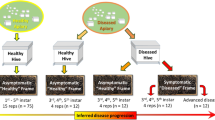First report on isolation and characterization of Bacillus Sp. associated with honey bee brood disease
First report on isolation and characterization of Bacillus Sp. associated with honey bee brood disease
Abstract
Bacterial infections in honey bee brood pose a significant threat to bee populations, leading to decreased honey production and disrupting critical crop pollination networks. While Paenibacillus larvae and Melissococcus plutonius are well-established as major pathogens of honey bee eggs and larvae, the presence of other harmful bacteria in the Khyber Pakhtunkhwa (KPK) province of Pakistan remains largely unexplored. Molecular characterization of Bacillus species and B. cereus isolates revealed the presence of key virulence genes, including the cry gene, known for its insecticidal properties. The ability of B. cereus to produce cytotoxins, haemolysins, and enterotoxins raises concerns about its impact on larval immunity and survival. Similarly, B. mycoides, a close relative of B. cereus, was identified in diseased broods, highlighting its potential involvement in microbial dysbiosis within the hive. Reports from North America and Europe have also linked these Bacillus species to declining honey bee health, emphasizing the need for further investigation into their pathogenic mechanisms. This study investigated bacterial contamination in broods collected from infected beehives across various cities of KPK. Biochemical and molecular analyses revealed a widespread presence of bacteria the Bacillus species, as the emerging most dominant, followed by Bacillus cereus. Phylogenetic analysis indicated a close evolutionary relationship between Bacillus species, and Bacillus cereus, highlighting their shared spore-forming characteristics. This research is the first to report the involvement of Bacillus species in infecting honey bee eggs and larvae, shedding light on a previously unrecognized threat to apiculture and pollination in the region.
Similar content being viewed by others
Introduction
Honey, a natural product highly valued for its nutritional and medicinal properties, exhibits remarkable longevity and resistance to spoilage due to its low water activity and high sugar concentration1. Despite these antimicrobial attributes, certain resilient microbial species can persist in this environment, posing a serious threat to honey bee health and overall colony sustainability2. Microbial contamination in honey typically originates from environmental sources such as pollen, flowers, air, dust, and the honey bee’s digestive system, with yeasts and bacteria forming the predominant microflora within beehives3,4). While honey bee larvae hatch in a sterile state, they are rapidly exposed to microbes through interactions with worker bees, pollen, and hive surroundings. The maintenance of healthy broods is crucial, as they replenish the short-lived worker bee population, sustain honey production, and ensure effective crop pollination5,6. However, honey bee populations worldwide are increasingly threatened by microbial pathogens, including viruses, fungi, and bacteria7.
Pakistan is home to diverse honey bee species, including the native Apis cerana and the introduced Apis mellifera, both of which play a vital role in honey production and crop pollination. Beekeeping is an important agricultural practice in the country, with approximately 10,000 registered beekeepers managing over 1.5 million colonies, producing more than 12,000 metric tons of honey annually8.The honey produced in Pakistan, particularly the Sidr (Ziziphus) honey, is renowned for its high quality and medicinal value, contributing significantly to the local economy and exports. Beekeeping not only provides livelihoods to thousands of families but also enhances agricultural productivity through pollination services, benefiting crops such as mustard, sunflower, and various fruits8,9.
Despite its economic and ecological significance, honey bee populations in Pakistan face multiple threats, including habitat destruction, climate change, pesticide exposure, and pathogen infections9. Brood diseases, in particular, pose a substantial risk to honey bee health, with bacterial pathogens contributing to colony losses. Among these, Paenibacillus larvae and Melissococcus plutonius—the causative agents of American foulbrood (AFB) and European foulbrood (EFB), respectively—are the most well-documented brood diseases worldwide, causing significant mortality in honey bee colonies10,11.
AFB, caused by the spore-forming P. larvae, is one of the most devastating bacterial diseases affecting honey bee broods. If left untreated, it can rapidly decimate entire colonies, as its highly resilient endospores allow the pathogen to persist in hives for years12,13. In contrast, EFB, caused by the non-spore-forming M. plutonius, primarily affects young larvae by outcompeting them for nutrients, leading to starvation and eventual death in the early developmental stages14,15.
Beyond these well-documented brood pathogens, the hive microbiome also harbors other spore-forming bacteria, including Bacillus cereus, a member of the Bacillus group, which comprises closely related species such as Bacillus mycoides16,17. While B. cereus is widely recognized for its pathogenic potential in humans, its impact on honey bee health remains unexplored. Given the close phylogenetic relationship between B. cereus, Paenibacillus larvae, and other Bacillus species, the potential role of Bacillus spp. in honey bee brood disease warrants further investigation18.
The increasing occurrence of unexplained colony losses highlights the urgent need to investigate honey bee brood diseases beyond well-known pathogens19,20. However, emerging pathogens in the hive microbiome remain poorly studied in Pakistan, necessitating further investigation This study aims to molecularly screen honey bee samples to assess the presence and diversity of Bacillus species-associated bacterial pathogens in the Khyber Pakhtunkhwa region of Pakistan. The findings contribute to a broader understanding of brood diseases and lay the groundwork for future studies aimed at protecting honey bee populations in the region.
Materials and methods
Study area
The samples were collected from ten different beehives containing diseased broods, found in the selected districts of central KPK provinces comprising of Mardan (34.1986° N, 72.0404° E), Nowshera (34.0105° N, 71.9876° E), Charsadda (34.1527° N, 71.7468° E), Swabi (34.1270° N, 72.4741° E), and Peshawar (34.0151° N, 71.5249° E). A Piece of about 20 cm2 containing a maximum portion of dead and discolored brood was obtained from each beehive. In this study geographical coordinates were identified using a Global Positioning System GPS. These coordinates were further used in the R Statistical Software version 4. 3. 1. to generate distribution map of the analyzed regions as the one shown in Fig. 1.



댓글
댓글 쓰기